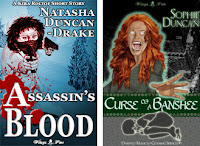Don't Lose Face!
For much of my writing life, I wrote fanfic, before I decided to turn my hand to being a professional word jockey. I still write fanfic from time to time because it's fun, and the one thing we don't have to worry about it describing our characters, because everyone knows what they look like. Oh, we describe their wounds or their clothing in loving details, and maybe their moles because we can, but with TV and movies they have the face of real actors and in books they have been lovingly described by their creator.
This is not the case in original fiction.
I don't know about you, but I forget things. While some people have perfect memories, crisp and clear like the screen of the latest smartphone, mine is more like an old rolodex where some of the cards are water damaged and others are missing entirely.
Also, I don't see my characters clearly in my head when I'm writing. They're more impressions than real people, even though I know who they are and what they are doing. This is fine when I'm in the first excited glow of creation, but coming back after a little while away from a project and it can make things tricky. All this has led me to one conclusion that I think can be really useful for all we mere mortals:
Character Bios are our friends!
Now anyone who knows me will tell you I write like a chaos demon. As it comes to me it goes on the page. I jump around the narrative, I fill bits in as I figure out what needs to go there, and I don't have a plan. Sometimes I write the end before I have any clue what the beginning is at all.
This is the opposite to my twin sister who has scene outlines longer than some of my scenes at times😆.
However, I have picked up the habit of filling out character bios. Not when I start - that would be too organised😉, but I create them when I introduce a character and fill them out as I go.
Do you realise how embarrassing it is to find out your main character has been swapping eye colour all the way through your novel?
Well I do 😆.
Yes, a good editor will catch such things, but just writing it down when we first decide on it saves so much time. I promise! Even the spelling of a name, or a person's full name is good to record. Hands up everyone who decided on the surname for a character, had a gap in writing and came back only to reinvent the wheel and give them a whole new one. *sheepishly waves hand in the air*
Most writing software like Scrivener and yWriter have specific places for character bios, but a normal Word document or an Excel Spreadsheet works just as well. I usually start with a simple template:
- Full Name:
- Known As:
- Age:
- Gender:
- Hair Colour:
- Eye Colour:
- Height:
- Ethnicity:
If we have a fantasy or sci-fi setting we can add things like race and powers, or for real world genres more mundane things like job etc.
We don't have to fill everything in, just whatever is relevant. Then we have a reference to refer back to if our rolodex gets even more soggy😉.
This technique really helped me when I was writing my serial stories as Virginia Waytes for the podcast. It's similar to how TV writers have show bibles so they can come back in anytime or pass the job on to a new member of the team. These little bios are nothing so grand, but boy, do they help me from getting in a right pickle. I heartily recommend using something along the same lines even if your writing is chaos embodied like mine!
Have you ever managed to forget what you named a character, or given them two different hair or eye colours? Or are you much more organised than me?😆
Check Out My Fiction YouTube Channel
- 🎤Micro stories/ jokes as YouTube Shorts Monday - Sunday- for fun quick viewing
- 🕮A longer story every now and then for story time, over coffee or before going to bed








